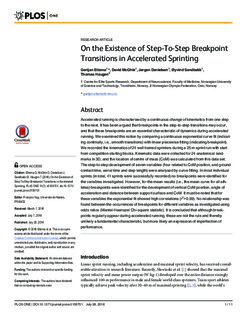| dc.contributor.author | Ettema, Gerardus Johannes C | |
| dc.contributor.author | McGhie, David | |
| dc.contributor.author | Danielsen, Jørgen | |
| dc.contributor.author | Sandbakk, Øyvind | |
| dc.contributor.author | Haugen, Thomas | |
| dc.date.accessioned | 2016-10-24T11:46:14Z | |
| dc.date.accessioned | 2016-10-26T09:06:37Z | |
| dc.date.available | 2016-10-24T11:46:14Z | |
| dc.date.available | 2016-10-26T09:06:37Z | |
| dc.date.issued | 2016 | |
| dc.identifier.citation | PLoS ONE 2016, 11(7) | nb_NO |
| dc.identifier.issn | 1932-6203 | |
| dc.identifier.uri | http://hdl.handle.net/11250/2417706 | |
| dc.description.abstract | Accelerated running is characterised by a continuous change of kinematics from one step
to the next. It has been argued that breakpoints in the step-to-step transitions may occur,
and that these breakpoints are an essential characteristic of dynamics during accelerated
running. We examined this notion by comparing a continuous exponential curve fit (indicating
continuity, i.e., smooth transitions) with linear piecewise fitting (indicating breakpoint).
We recorded the kinematics of 24 well trained sprinters during a 25 m sprint run with start
from competition starting blocks. Kinematic data were collected for 24 anatomical landmarks
in 3D, and the location of centre of mass (CoM) was calculated from this data set.
The step-to-step development of seven variables (four related to CoM position, and ground
contact time, aerial time and step length) were analysed by curve fitting. In most individual
sprints (in total, 41 sprints were successfully recorded) no breakpoints were identified for
the variables investigated. However, for the mean results (i.e., the mean curve for all athletes)
breakpoints were identified for the development of vertical CoM position, angle of
acceleration and distance between support surface and CoM. It must be noted that for
these variables the exponential fit showed high correlations (r2>0.99). No relationship was
found between the occurrences of breakpoints for different variables as investigated using
odds ratios (Mantel-Haenszel Chi-square statistic). It is concluded that although breakpoints
regularly appear during accelerated running, these are not the rule and thereby
unlikely a fundamental characteristic, but more likely an expression of imperfection of
performance. | nb_NO |
| dc.language.iso | eng | nb_NO |
| dc.publisher | Public Library of Science | nb_NO |
| dc.rights | Navngivelse 3.0 Norge | * |
| dc.rights.uri | http://creativecommons.org/licenses/by/3.0/no/ | * |
| dc.title | On the existence of step-to-step breakpoint transitions in accelerated sprinting | nb_NO |
| dc.type | Journal article | nb_NO |
| dc.type | Peer reviewed | nb_NO |
| dc.date.updated | 2016-10-24T11:46:14Z | |
| dc.source.volume | 11 | nb_NO |
| dc.source.journal | PLoS ONE | nb_NO |
| dc.source.issue | 7 | nb_NO |
| dc.identifier.doi | 10.1371/journal.pone.0159701 | |
| dc.identifier.cristin | 1394040 | |
| dc.description.localcode | © 2016 Ettema et al. This is an open access article distributed under the terms of the Creative Commons Attribution License, which permits unrestricted use, distribution, and reproduction in any medium, provided the original author and source are credited. | nb_NO |

